REU Past Students
2023 2022 2021 2019 2018 2017 2016 2015 2014 2013 2012 2011
2013
-
Christopher Armenia - Chemistry, Villanova University
 Educational Institution: Villanova University
Educational Institution: Villanova University
List of Mentors: Dr. Eva Harth & Dan Beezer
Program: NSF REU
Research Project: Derivatization of Polyglycidol and the Synthesis of Hydrogels by Oxime Click Chemistry
Poster: NSF REU Christopher Armenia Poster.pdf
Research Abstract:
A hydrogel is a network of hydrophilic polymers that has the ability to absorb water. These gels have similar properties to human organs and tissues, and thus have many medical applications, such as drug transport and gene therapy. These hydrogels can act as a matrix to which biomedical nanoparticles can be attached and allow drugs to be more effectively delivered throughout the human body. This project focused on the synthesis of polyglycidol hydrogels by functionalizing polyglycidol polymers and reacting these various derivatives with each other. Three different polyglycidols were synthesized: amino-oxy polyglycidol, 3-mercaptopropanoyl polyglycidol, and 4-pentenoyl polyglycidol. In order to characterize the properties of the derivatives that were synthesized, model reactions were conducted using 3-ethoxy-1,2-propanediol because it has similar functional groups to polyglycidol. Using click reactions, three hydrogels were synthesized: the first was composed of 3-mercaptopropanoyl polyglycidol and 4-pentenoyl polyglycidol, the second was composed of 4-pentenoyl polyglycidol and 3,6-dioxa-1,8-octanedithiol which acted as a linker between the polymers, and the third was composed of the amino-oxy polyglycidol and a previously synthesized polymer of o-phenylenediamine and valerolactone. These gels are further characterized of their functionalities and physical properties. -
Megan Burcham - Engineering, University of Tennessee, Martin
 LinkedIn
LinkedIn
Educational Institution: University of Tennessee, Martin
List of Mentors: Dr. Peter Pintauro & Ethan Self
Program: NSF TN-SCORE
Research Project: Influence of Polymer Binder Properties on the Performance of Si-Based Anodes for Li-ion Batteries
Poster: NSF REU Megan Burcham Poster.pdf
Research Abstract:
Since their 1990 market debut by Sony, Li-ion batteries (LIBs) have become a popular energy storage platform for portable electronic devices. Electric vehicles powered by LIBs have also experienced recent successes, but they are currently limited to short range commutes due to the low capacity of electrode materials. Silicon is a promising candidate for next generation LIB anodes due to its high theoretical capacity (3,576 mAh/g), which is an order of magnitude greater than that of graphite (372 mAh/g) used today in commercial battery anodes. Industrial adaptation of Si anodes, however, has been hindered by complications arising from Si volumetric changes (~400%) during battery charging and discharging. These volumetric swings ultimately lead to poor capacity retention resulting from Si electronic isolation and an unstable solid-electrolyte interface. In this study, a number of polymers —poly(acrylic acid), carboxymethyl cellulose, poly(vinyl butyral-co-vinyl alcohol-co-vinyl acetate), and poly(vinylidene fluoride)—were investigated as potential binders to accommodate Si swelling without compromising the overall electrode integrity. The selected polymers contained different functional groups to better understand the effects of Si-binder and binder-electrolyte interactions on anode stability. Thermally induced polymer crosslinking was also examined as a way to house Si volume changes without disrupting the electronic conductivity network. Composite anodes containing Si nanoparticles and conductive carbon powder embedded in a polymeric binder were characterized in Li-ion half-cells where anode performance was evaluated by means of cyclic charge/discharge experiments. These composite anodes exhibited outstanding initial capacities, exceeding 1,000 mAh/g. Moderately stable anodes were obtained using binders that (i) participated in hydrogen bonding with the Si-O surface layer on the Si nanoparticles and (ii) exhibited low swelling in the battery electrolyte. Crosslinking the polymeric binders did not further enhance capacity retention. These findings will be used as reference data for future studies that will focus on silane surface modified Si nanoparticles. -
Emily Darby - Chemistry, Pomona College
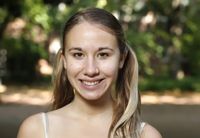 LinkedIn
LinkedIn
Educational Institution: Pomona College
List of Mentors: Dr. David Cliffel & Gabriel Leblanc
Program: NSF REU
Research Project: Transparent Reduced Graphene Oxide Electrodes with Photosytem I for Photoconversion
Poster: NSF REU Emily Darby Poster.pdf
Research Abstract:
Photosystem I (PSI) is a photoreactive electron transport protein found in plants that participates in the process of photosynthesis. Because of PSI’s abundance in nature and its efficiency with charge transfer and separation, we are interested in applying the protein to photovoltaic devices. Past research has shown increased photocurrents by integrating PSI with graphene electrodes. Here, we developed a transparent, conductive electrode using reduced graphene oxide (RGO) on which PSI could be deposited. The electrodes were characterized using Raman spectroscopy, UV-Vis spectroscopy, and electrochemical techniques; and we determined the photocurrent density in varying concentrations of several mediator solutions.The use of transparent RGO electrodes is an attractive alternative to graphene because it affords facile and inexpensive production through chemical processes. Furthermore, the transparency of the RGO electrode gives us the ability to utilize an opaque mediator solution, such as dichloroindophenol. The resulting photoelectrode demonstrated current densities comparable to a gold electrode modified with PSI and significantly higher than a graphene electrode modified with PSI. The relatively large photocurrents produced by integrating PSI with RGO and using an organic mediator can be applied to the production of more economic, easily produced, and completely organic solar cells.
- Darby 1st author on Langmuir Journal Publication
E. Darby, G. LeBlanc, E.A. Gizzie, G.K. Jennings, and D.E. Cliffel, “Photoactive Films of Photosystem I on Transparent Reduced Graphene Oxide Electrodes,” Langmuir, 30 (29), 8990-8994 (2014).
- Conference Presentations
-E. Darby, G. LeBlanc, G. K. Jennings, and D. E. Cliffel “Transparent Reduced Graphene Oxide with Photosystem I for Photoconversion,” Pacific Conference on Spectroscopy and Dynamics, Pacific Grove, CA, January, 2014.
-E. Darby, G. LeBlanc, G. K. Jennings, and D. E. Cliffel “Transparent Reduced Graphene Oxide with Photosystem I for Photoconversion,” Southern California Undergraduate Research Conference in Chemistry and Biochemistry, Irvine, CA, April, 2014. (oral presentation) - Emily was awarded 2014 Goldwater Scholarship.
- Emily was awarded a NSF Graduate Research Fellowship in 2015.
- Darby 1st author on Langmuir Journal Publication
-
Domenic DiGiovanni - Physics/Economics, Hillsdale College
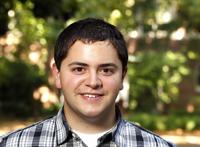 LinkedIn
LinkedIn
Educational Institution: Hillsdale College
List of Mentors: Dr. Yaqiong Xu & Roel Flores
Program: NSF TN-SCORE
Research Project: Chemical Treatment Effects on the Photoluminescence and Raman Spectra of Atomically-Thin Molybdenum Disulfide
Poster: NSF REU Dominic DiGiovanni Poster.pdf
Research Abstract:
Monolayers of the transition-metal dichalcogenide molybdenum disulfide exhibit properties that could make the material ideal for future nano-scale optoelectronic applications. The monolayers’ direct bandgap property and photocurrent-generating ability makes single-layer MoS2 a promising material for use in nano-scale devices such as high-sensitivty photodetectors. This study focuses on the changes of MoS2 monolayers’ photoluminescence (PL) and Raman spectra due to chemical treatments. Samples of few-layer and single-layer MoS2 obtained using mechanical exfoliation and transferred to SiO2 substrates were treated with ozone or oxygen plasma. The flakes were identified using optical microscopy and analysis of Raman spectra; their PL and Raman spectra were measured before and at various stages during the plasma treatment. Synthesis of MoS2 monolayers using a vapor-solid method for the purpose of comparative study was also attempted and is discussed. This study demonstrates that the photoluminescence of the monolayers increases by up to a factor of four with the plasma treatments, perhaps due to the adsorption of oxygen. In the future, we plan to improve our synthesis methods and to investigate how optoelectronic properties of MoS2 phototransistors’ can be altered by chemical and x-ray treatments. -
Jon Paul Elizondo - Mechanical Engineering, Texas A&M University
 Educational Institution: Texas A&M University
Educational Institution: Texas A&M University
List of Mentors: Dr. Cary Pint & Dr. Rizia Bardhan & Landon Oakes
Program: NSF REU
Research Project: Electrophoretic Deposition of Nanomaterials for Plasmonically Enhanced Photodetectors
Poster: NSF REU Jon Paul Elizondo Poster.pdf
Research Abstract:
Nanocarbon materials coupled with plasmonically active nanoparticles show great promise in ultrafast, tunable photodetection. However, current methods for producing such devices are costly and non-scalable, making them impractical for manufacturing. In this study, we propose electrophoretic deposition (EPD) as an alternative means for fabricating structures necessary for plasmonically enhanced photodetectors. EPD is a scalable, cost-effective assembly method that utilizes coulombic interactions to deposit materials onto a substrate. Typical substrates used in the EPD process are conductors; however, through the application of novel EPD techniques we have deposited films of Au nanoparticles and graphene onto dielectrics, creating morphologies suited for plasmonic photodetection. Tests of these devices indicate slight plasmonic activity (~1% difference), and we believe that future optimization of the EPD process will significantly improve these results. -
Timothy Haley - Physics, University of Tennessee, Chattanooga
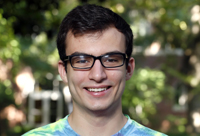 LinkedIn
LinkedIn
Educational Institution: University of Tennessee, Chattanooga
List of Mentors: Dr. Kirill Bolotin & Hiram Conley
Program: NSF TN-SCORE
Research Project: Chemical Vapor Deposition of Atomically Thin Films of MoS2 for Electro-Optical Devices
Poster: NSF REU Timothy Haley Poster.pdf
Research Abstract:
After graphene was developed and the scientific community began to understand its properties and limitations, it became prudent to explore other two-dimensional materials. Molybdenum Disulfide is a dry lubricant with similar properties to graphite. Likewise, we may confine it to a single layer, where it becomes an atomically thick, 2D material. Unlike graphene, monolayer Molybdenum Disulfide is a direct band gap semiconductor. This property allows monolayer MoS2 to be useful in the field of optics and will allow monolayer MoS2 to be integrated into modern electronic devices like resonators and transistors. As of now, the majority of monolayer MoS2 is obtained by using exfoliation methods. These methods produce quality monolayers but have limited flake size. Here, we explore chemical synthesis processes for creating millimeter-sized atomically thin films of MoS2. We then intend to use this material to fabricate tunable electro-optical devices. In these devices, a film of MoS2 suspended over a hole can be controllably strained using a gate electrode. Since it has been shown that the band gap of monolayer MoS2 is inversely proportional to strain, the band gap of these membranes -- and hence their optical absorption and photoluminescence -- would be tunable by controlling their deflection. These devices could have the potential to create more efficient photovoltaic devices, tunable lasers, and excitonic concentrators. -
Jeffrey Holzgrafe - Engineering & Physics, Olin College
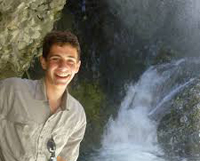 Educational Institution: Olin College
Educational Institution: Olin College
List of Mentors: Dr. Cary Pint & Landon Oakes
Program: NSF REU
Research Project: Electrophoretic Deposition for Inexpensive Carbon Nano-Composite Lithium Air Battery Cathodes
Poster: NSF REU Jeff Holzgrafe Poster.pdf
Research Abstract:
Lithium air batteries take advantage of a reversible oxidation reaction of lithium with O2 to create a rechargeable energy source with energy densities that could approach that of gasoline. We demonstrate that the relatively inexpensive and easily scaled process of electrophoretic deposition can be used to create carbon nanotube-nanohorn composite air electrodes for Li-air batteries. Preliminary results suggest that these composite materials improve the specific capacity of Li-air batteries over that of nanotube only materials. While significant work is still required to control and optimize these composites, the results suggest that electrophoretic deposition is a viable high-throughput process for manufacturing improved Li-air battery cathodes.- Co-author Journal Publication
R. Carter, L. Oakes, J. Holzgrafe, H. Zarick, S. Chatterjee, R. Bardhan, and C. Pint, “Solution assembled single walled carbon nanotube foams; Superior performance in supercapacitors, lithium ion, and lithium air batteries,” Journal of Physical Chemistry, 118 (35), 20137-20151 (2014). - Holzgrafe named 1st Marshall Scholar at Olin College
- Holzgrafe awarded 2014 Goldwater Scholarship
- Co-author Journal Publication
-
Olivia Hurd - Engineering, Vanderbilt University
 LinkedIn
LinkedIn
Educational Institution: Vanderbilt University
List of Mentors: Dr. Rizia Bardhan & Holly Zarick
Program: NSF TN-SCORE
Research Project: Au@SiO2 Core-Shell Nanocubes for Plasmon-Enhancement of Dye-Sensitized Solar Cells
Poster: NSF REU Olivia Hurd Poster.pdf
Research Abstract:
As the need for renewable sources of energy has become a more pressing topic, a number of solutions have been presented and remain in the running as promising sources of energy, solar cells included. In order for any energy source to remain competitive, devices must constantly make advances in terms of cost and efficiency. In the field of photovoltaics, dye-sensitized solar cells (DSSCs) were introduced as an economical alternative to the traditional silicon-based solar cells, but modifications can still be made to improve the efficiencies of these DSSCs and make them more comparable to the traditional solar cells. This project focuses on improving the photo conversion efficiencies of these cells through plasmon-enhancement. Brown et al. [Plasmonic Dye-Sensitized Solar Cells Using Core-Shell Metal-Insulator Nanoparticles. Nano Lett. 2010, 11, 438-445] showed efficiency improvements through plasmon-enhancement achieved with core-shell Au@SiO2 nanospheres. Similarly, this project focuses on the integration of Au@SiO2 nanocubes. These nanocubes, as opposed to nanospheres, show near-field enhancement at their corners and edges due to localized surface plasmons, which prompts greater efficiencies in the completed cells. The DSSCs are enhanced and tested using two different incorporation geometries of the nanocubes, top layer and imbedding. Top layer geometry is achieved by airbrushing the nanocubes over the layer of titania on the anode of the cell, so that they remain mostly on top of the titania. Cells with the imbedded geometry are made by mixing the nanocubes directly into titania paste before it is added as a layer onto the cell. The efficiencies of these enhanced cells and those of reference cells lacking nanoparticles are tested using a solar simulator and a potentiostat, and the photo conversion efficiencies of DSSCs with incorporated nanocubes are found to be greater. Future work will continue to compare the efficiencies of reference cells with those of Au@Ag@SiO2 nanocube-enhanced DSSCs.- Co-author Journal Publication
-H.F. Zarick, O. Hurd, J.A. Webb, Chanse Hungerford, and Rizia Bardhan, “Enhanced Efficiency in Dye-Sensitized Solar Cells with Shape-Controlled Plasmonic Nanostructures,” ACS Photonics, 1 (9), 806-811 (2014).
-H. F. Zarick, W. R. Erwin, A. Boulesbaa, O. Hurd, J. A. Webb, A. Puretzky, D. Geohegan, R Bardhan*, "Improving Light Harvesting in Dye Sensitized Solar Cells using Hybrid Bimetallic Nanostructures", ACS Photonics, 3, 385–394 (2016).
- Co-author Journal Publication
-
Jacob Jordan - Engineering, Tennessee Tech University
 Educational Institution: Tennessee Tech University
Educational Institution: Tennessee Tech University
List of Mentors: Dr. David Cliffel & Gabriel LeBlanc
Program: NSF TN-SCORE
Research Project: Synthesis of Polyviologens as Mediators for Photosystem I-Based Assemblies
Poster: NSF REU Jacob Jordan poster.pdf
Research Abstract:
Photosystem I (PSI) is a well-studied integral membrane protein that is found in algae, bacteria, and plants that mediates electron photo-excitation. When an electron within PSI is excited by light, it is transported across the protein through a series of electron accepting steps in the electron transport chain and is finally carried to the Fb site, an iron-sulfur complex that acts as a final electron acceptor. This project centers around removing electrons from the Fb site to a counter electrode in order to complete the circuit. Viologens have been an interesting mediator type to study as they have a formal potential very similar to that of the Fb site and thus can accept the electron from PSI with relatively little energy loss. Polyviologens are of specific interest as the polymer network allows increased electron transfer, reduces orientation effects, stabilizing PSI, and allowing a three-dimensional network. Electrochemical tests involving various electrode setups allowed us to generate photo-response data for polyviologens when used in conjunction with PSI. The polyviologens were synthesized using the Menshutkin reaction and characterized with 1H NMR and electrochemistry. Two different PSI-polymer electrode setups were assembled in order to test the photo-response: a gold macro-electrode system that was alternately layered with a polymer and PSI; and a heavily-P-doped silicon electrode system that used the polymers as aqueous mediators. -
Helena Keller - Chemical Engineering, Michigan Tech University
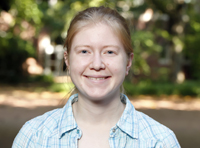 Educational Institution: Michigan Tech University
Educational Institution: Michigan Tech University
List of Mentors: Dr. Kane Jennings & Leo Yang
Program: NSF REU
Research Project: Organic Monolayers on p-Doped Silicon Affect Photocurrents of Photosystem I Films
Poster: NSF REU Helena Keller Poster.pdf
Research Abstract:
Biohybrid solar cells convert light energy to electricity through the use of Photosystem I (PSI), a protein complex that drives photosynthesis in green plants. The near-one-hundred percent quantum efficiency of PSI, in addition to its vast abundance in nature, gives this technology enormous potential as a sustainable source of energy. Prior work from our group has shown that PSI films on p-doped silicon yield photocurrents that approach 1 mA/cm2, far exceeding those for PSI on metals or for unmodified silicon. In this project, we have investigated the use of organic monolayers deposited between the p-doped silicon semiconductor and the PSI layer to facilitate electron transfer and increase the stability of the PSI film. These monolayers were prepared by exposing silicon to solutions containing -terminated alkynes to produce an alkenyl attachment of the monolayer to silicon and create a surface of the -terminated functionality for interaction with PSI. Of the monolayer surface groups tested, including alcohols, amines, carboxylic acids, and covalently reactive groups, the carboxylic acid terminus most consistently achieved the highest photocurrents, suggesting favorable electrostatic attraction between the negative surface of the monolayer and positive patches on PSI. Carboxylic acids of varying carbon chain lengths—specifically three, five, six, and seven carbons—were then tested using photochronoamperometry in order to observe the effect of monolayer thickness on photocurrent as well as the stability of the photocurrent over time.- Conference Presentation
H. Keller, S. Yang, G. LeBlanc, D. E. Cliffel and G. K. Jennings. “Organic Monolayers on p-Doped Silicon Affect Photocurrent of Photosystem I Films,” 2013 AIChE Annual Meeting: Global Challenges for Engineering a Sustainable Future, San Francisco, CA, November, 2013. - Helena was awarded a $1K travel grant at the capstone poster session.
- Helena was awarded a NSF Graduate Research Fellowship
- Conference Presentation
-
John Lonai - Physics & Engineering, Northwest Nazarene University
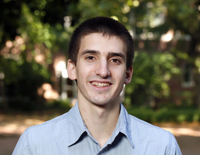 LinkedIn
LinkedIn
Educational Institution: Northwest Nazarene University
List of Mentors: Dr. Sharon Weiss & Gilbert Rodriquez
Program: NSF REU
Research Project: Optimized porous silicon Bloch surface and sub-surface wave structure for simultaneous detection of small and large molecules
Poster: NSF REU Poster John Lonai.pdf
Research Abstract:
A Porous silicon (PSi) Bloch surface and sub-surface wave (BSW/BSSW) biosensor is optimized and demonstrated for the size selective detection of both small and large molecules. PSi biosensors have been previously shown to offer enhanced label-free sensing of small biological and chemical molecules that can infiltrate the pores due to a large internal surface area and tunable optical properties. The PSi BSW/BSSW biosensor offers the possibility to sensitively detect both small molecules that infiltrate the pores and large molecules attached on the sensor surface. The BSW/BSSW structure consists of a periodic stack of high and low refractive index layers, known as a Bragg mirror, with a reduced optical thickness surface layer. The truncated surface layer gives rise to a BSW with an evanescent tail that extends above the surface and enables the detection of large surface-attached molecules that cannot penetrate the porous matrix. Implementation of a step or gradient refractive index profile within the Bragg mirror generates a large electric field intensity spatially localized to a desired region of the mirror, known as the BSSW. The BSSW mode is entirely confined within the multilayer Bragg mirror and can detect small molecules attached within the pores with an enhanced sensitivity compared to other PSi biosensor designs. The design and experimental realization of optimized step and gradient refractive index profiles necessary to realize the BSSW is presented here for the first time. The PSi BSW/BSSW biosensor is designed using rigorous coupled wave analysis and transfer matrix theory simulations. Size-selective molecular detection is demonstrated using a prototypical small chemical molecule, 3-Aminopropyltrimethoxysilane (3-APTES; size of 0.8 nm) and large, 60 nm carboxyl latex nanospheres. Attachment and quantification of the small and large species are performed by monitoring the angle-resolved reflectance spectrum of the PSi BSW/BSSW structure. The BSW and BSSW modes are each manifested as a distinct resonance peak in the spectrum, and the angular shift of each peak can be used to quantify the number of molecules or nanospheres attached to the sensor. Detection and quantification of the 3-APTES attachment and nanosphere binding is separately performed with the BSSW mode and BSW mode, respectively. Good agreement between theoretical simulations and experimental measurements is found for both the PSi step and gradient BSW/BSSW biosensors. The size-selective detection of both small and large molecules using the same sensor platform is expected to be a significant advantage for future multi-analyte detection schemes using a microfluidics approach.- Co-author Journal Publication
G. Rodriguez, J.D. Lonai, R.L. Mernaugh, and S.M. Weiss, “Porous silicon Bloch surface and sub-surface wave structure for simultaneous detection of small and large molecules,” Nanoscale Research Letters, 9 (1), 383 (2014). - Conference Presentation
G. A. Rodriguez, J. D. Lonai, and S. M. Weiss, “Porous silicon Bloch surface and sub-surface wave structure for simultaneous detection of small and large molecules,” Porous Semiconductors – Science and Technology Conference, Benidorm, Alicante, Spain, March, 2014. [selected as invited talk by peer review]
- Co-author Journal Publication
-
Katina Mattingly - Engineering & Physics, Murray State University
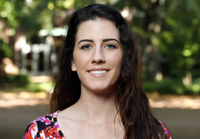 LinkedIn
LinkedIn
Educational Institution: Murray State University
List of Mentors: Dr. Jason Valentine & Wei Li
Program: NSF REU
Research Project: Development of nanophosphor films for use in thermometry of nanoscale thermoplasmonic antennae
Poster: NSF REU Katina Mattingly Poster.pdf
Research Abstract:
With a variety of applications in optics, semiconductors, and drug delivery; thermoplasmonic nanoantennae, which act as nanoscale heat sources, have a growing need for optimization and characterization. Current thermometry techniques that implement phosphors involve a high temperature annealing step. This step, used after deposition of the phosphor film, limits the device design and allowable substrates. In this project, an improved thermometry technique based on nanophosphors is investigated in an effort to improve current thermal characterization ability. To achieve maximum detector coverage, a nanoparticle phosphor film has been developed. Cerium doped yttrium aluminum garnet phosphor powder was first created via combustion synthesis and then transformed into nanoparticles via laser ablation. The nanoparticles are distributed onto nanoscale plasmonic devices in a uniform film that is utilized to detect the local temperature through the temperature dependent photoluminescence lifetime of the phosphor. The proposed thermometry technique removes the necessity of an annealing process, allowing for greater flexibility in device design and material. This research will help optimize thermometry of thermoplasmonic antennae and remove limitations on design parameters. -
Marc Panu - Chemical Engineering, Vanderbilt University
 LinkedIn
LinkedIn
Educational Institution: Vanderbilt University
List of Mentors: Dr. Bridget Rogers & Courtney Mitchell
Program: NSF TN-SCORE
Research Project: Fabrication of Gadolinium Aluminum Garnet Phosphor by Combustion Synthesis
Poster: NSF REU Marc Panu Poster.pdf
Research Abstract:
Cerium-doped gadolinium aluminum garnet (GAG:Ce) can be used to improve the efficiency of white-light LEDs (light emitting diodes). The Rogers group has gained expertise in combustion synthesis of yttrium aluminum garnet doped with Ce and/or Eu, however the process procedure does not produce good quality, pure phase GAG. This project focused on developing a gel-combustion synthesis of GAG:Ce. Photoluminescence (PL) spectroscopy, powder x-ray diffraction (XRD), and x-ray photoelectron spectroscopy (XPS) were used to characterize the effects of processing conditions on the resulting materials’ properties. Fuel type, combustion temperature, annealing temperature and annealing time were investigated. XRD showed that nearly pure phase GAG was formed by using citric acid as the fuel, a combustion temperature of 500°C, and a 4.5 hour, 1100 °C anneal. The trends observed in our results are consistent with phase diagrams that indicate pure-phase GAG should be formed at 1200 °C and above. Material combusted at 400 °C and annealed for 14 hours at 1100 °C had the most intense PL emission but did not contain the most garnet phase of the materials produced. This observation indicates PL emission intensity depends on factors in addition to crystal phase. We investigated the effects of host doping on GAG PL intensity. Yttrium was substituted for gadolinium, and gallium was substituted for aluminum in the GAG lattice. XRD and XPS analyses were used to interpret the trends in PL emission of these host-doped materials.- Conference Presentations
-M. Panu, C. A. Mitchell, S.L. Gollub, B.R. Rogers, and G. Walker, “Optical Property Tuning of Cerium-Activated Gadolinium Aluminum Garnet Phospor Powders,” GEM 2013: Expanding Our Horizons, San Juan, Puerto Rico, August, 2013.
-M. Panu, C. A. Mitchell, S.L. Gollub, B.R. Rogers, and G. Walker, “Combustion Synthesis of Gadolinium Aluminum Garnet (GAG) Phosphor,” AICHE conference, San Francisco, CA, November, 2013.
-M. Panu, C. A. Mitchell, S.L. Gollub, B.R. Rogers, and G. Walker, “Optical Property Tuning of Cerium-Activated Gadolinium Aluminum Garnet Phospor Powders,” National Society of Black Engineers -Region 3, Lexington, KY, November, 2013. *won first place able to present at National NSBE conference
-M. Panu, C. A. Mitchell, S.L. Gollub, B.R. Rogers, and G. Walker, “Optical Property Tuning of Cerium-Activated Gadolinium Aluminum Garnet Phospor Powders,” National Society of Black Engineers -National Meeting, Nashville, TN, March, 2014.
- Conference Presentations
-
Michael Reynolds - Physics, Columbia State Community College
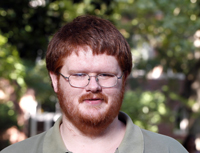 LinkedIn
LinkedIn
Educational Institution: Columbia State Community College
List of Mentors: Dr. Richard Haglund & Jed Ziegler
Program: NSF REU
Research Project: Good Vibrations: Plasmon-Exciton Coupling in Gold/Molybdenum Disulphide Hybrid Systems
Poster: NSF REU Michael Reynolds Poster.pdf
Research Abstract:
Monolayer Molybdenum Disulphide (MoS2), a two dimensional transition metal dichalcogenide, has interesting optical and electronic characteristics, specifically a direct optical band gap of 1.85 eV that is tunable by stress, applied voltage, as well as optical excitation source intensity. This band gap along with a large (0.5 eV) exciton binding energy makes MoS2 an attractive candidate for applications in two dimensional photoelectronics. In this study, we intend to couple the excitons from MoS2 to a second species of bound state generated in gold nanoparticles, the local surface plasmon, which is the oscillation created by electron cloud and photon wave coupling as light passes through metallic particles. We fabricate gold nanorods of varying lengths on top of MoS2 flakes separated by a spacer layer to promote direct coupling between the two bound states, excitons and plasmons. Photoluminescence measurements are taken using excitation energies at 532 nm and 633 nm, to probe the exciton-plasmon binding behavior of the hybrid system. This system presents in two configurations, which are observable in the photoluminesce and extinction spectra: off resonant enhancement or on resonant binding. Off resonant enhancement occurs when the resonant energy of the plasmon occurs at a higher energy than the energy of the exciton, resulting in an increase in exciton emission intensity. On resonant binding occurs when the resonant energy of the plasmon is equal to the exciton energy and results in a significant blue shift and enhancement of the MoS2 excitonic photoluminescent peaks. This typically signifies strong, coherent coupling between the exciton and plasmon, a bound state termed plexcitons. The plexciton could be used to modulate and enhance the excitonic properties of MoS2 and thereby introduce further versatility to MoS2-based two dimensional transistors. -
Ryan Rhoades - Physics & Applied Math, Florida State University
 Educational Institution: Florida State University
Educational Institution: Florida State University
List of Mentors: Dr. Richard Haglund & Rod Davidson
Program: NSF REU
Research Project: Mapping Plasmonic Response of Nanostructures via Multiphoton Absorption in Poly (methyl methacrylate)
Poster: NSF REU Ryan Rhoades Poster .pdf
Research Abstract:
The near-field plasmon response of nanoparticles has previously been mapped by complex techniques such as electron energy-loss spectroscopy (EELS) and scanning near-field optical microscopy (SNOM). However, recent research has shown that four-photon absorption in poly(methyl methacrylate) (PMMA) is a more efficient way to map and characterize localized surface-plasmon resonance modes. In this work, the use of PMMA development as an optical means to characterize plasmonic responses in the near-field is verified with simple nanoparticles and then applied to more complex structures with resonance modes that have been only computationally observed. Nanoparticles were spin-coated with PMMA, exposed to an Ti:sapphire laser to induce areas of intense electric fields that cause polymer scission. Once the polymer is developed, it is characterized by scanning-electron microscopy to create an electric near-field intensity profile that corresponds with areas where the strong localized surface-plasmon resonance has generated the largest electric field. This process then will be used to experimentally map multiple plasmonic modes in gold Archimedean nanospirals. Future studies will refine and optimize this characterization technique and apply it to additional complex resonance modes in nanospirals and other asymmetric nanoparticles. -
John Shannon - Biochemistry, Colorado State University
 LinkedIn
LinkedIn
Educational Institution: Colorado State University
List of Mentors: Dr. James Crowe
Program: NSF REU
Research Project: Exploring Respiratory Syncytial Virus Fusion and Matrix Protein Interactions in Membranes Using Recombinant Proteins and Nanodiscs
Poster: NSF REU John Shannon Poster .pdf
Research Abstract:
Respiratory syncytial virus (RSV) belongs to the Paramyxoviridae family and is the leading cause of severe viral respiratory disease in young children, the elderly and immunocompromised individuals. Currently, there is no effective vaccine available and each year there are over 64 million reported cases of RSV resulting in ~160,000 deaths worldwide. RSV infects predominately epithelial cells of the upper respiratory tract, and little is known about how the virus mediates viral assembly and release in the host. In cell culture systems, it has been shown that RSV infects at, and is released from, the apical surface of polarized cells and exhibits distinct and dynamic filamentous structures in non-polarized cells. Our laboratory has previously shown that RSV viral filament formation requires interaction of the viral nucleoprotein (N), matrix (M) protein, and phosphoprotein (P) through a terminal phenylalanine (Phe) residue of the fusion protein cytoplasmic tail (F CT). We hypothesized that RSV M and RSV F have a transient interaction that mediates assembly of the viral proteins into filamentous structures prior to budding and release from epithelial cells. Data provided here using site-directed mutagenesis and confocal microscopy show attenuated filament formation in RSV M mutants, as compared to those that possess the wild-type sequence of M protein. Given the transient nature between RSV M and F, it has been difficult to detect the interaction through commonly used molecular and cell biology techniques. We sought to develop an innovative method to examine the transient interaction between these viral proteins utilizing nanodiscs and Förster resonance energy transfer (FRET). We generated a RSV F CT wild-type recombinant soluble protein and a F CT (F22A) mutant protein to be assembled and displayed in a nanodisc platform, and we used these constructs in interaction assays using FRET-based technologies. This approach will provide a practical method for examining transient protein-protein interactions that occur only in the context of lipid bilayer membranes. Data obtained through these various assays provides insight into the mechanism controlling RSV viral egress, leading towards the development of novel disease interventions- Conference Presentation
J.P. Shannon, J.A. Pickens, J.E. Crowe, “Exploring Respiratory Syncytial Virus Fusion and Matrix Protein Interactions in Membranes Using Recombinant Proteins and Nanodiscs,” Keystone Symposia: Pathogenesis of Respiratory Viruses, Keystone Colorado, January, 2014. - John was awarded a $1K travel grant at the capstone poster session.
- John was a 2016-2017 and 2017-2018 NIH IRTA fellow
- John was awarded an NIH Oxford-Cambidge Scholarship in 2018
- Conference Presentation
-
Corban Swain - Biomedical Engineering, Washington University, St. Louis
 LinkedIn
LinkedIn
Educational Institution: Washington University, St. Louis
List of Mentors: Dr. Craig Duvall & Chris Nelson
Program: NSF REU
Research Project: Controlled Release of siRNA from Hydrolytically Degradable Nanomicelles for Potent Gene Knockdown
Poster: NSF REU Corban Swain Poster .pdf
Research Abstract:
RNA interference—an endogenous system in eukaryotic cells by which double-stranded RNAs lead to the degradation of complementary mRNA—can be exploited by small interfering RNAs (siRNAs) to silence almost any gene in the human body.[1] This premise allows siRNA to be utilized as a targeted therapeutic agent against disease. However, siRNA alone is prone to degradation by enzymes and marked by limited transfection into cells; moreover, delivery is the primary barrier to the use of siRNA as a therapeutic. Our previous work has shown safe and effective delivery of siRNA and gene silencing in cells with the use of PEG-shielded#, pH-responsive, endosomolytic, micellar nano-polyplexes (NPs) formed from diblock copolymers[2] (poly(EG-b-[BMA-co-DMAEMA]))*.Intracellular release of siRNA from NPs once they have been internalized is a limiting step in siRNA bioavailability and bioactivity. In this study, working under the motivation to have greater siRNA release post endosomal escape, we employ a new set of polymers (poly(EG-b-[BMA-co-DMAEA]))** capable of self-catalyzed hydrolysis. In aqueous solution, poly(DMAEA) will degrade to poly(acrylic acid) and a benign alcohol; by this process the positive charge on the BMA-co-DMAEA polymer block will undergo charge reversal over time, leading to decomplexation and release of negatively charged siRNA. Förster resonance energy transfer (FRET) studies showed our hydrolytically degradable (HDG) NPs to have significantly greater release (with tunability) of labeled DNA over time when compared to non-HDG NPs. Flow cytometry measurements showed comparable cellular uptake for HDG NPs vs. non-HDG NPs at multiple dosages, proving that cellular uptake is not significantly reduced despite the different polymer chemistry of our HDG NPs. These data suggest that HDG NPs are a novel platform to improve siRNA gene silencing through enhanced intracellular bioavailability. Ongoing work will confirm improved intracellular release and bioactivity of HDG NPs relative to our established non-HDG NP system.
- Co-author Journal Publication
T.A. Werfel, C. Swain, C.E. Nelson, K.V. Kilchrist, B.C. Evans, M. Miteva,C.L. Duvall, “Hydrolytic Charge-reversal of PEGylated Polyplexes Enhances Intracellular Un-packaging and Activity of siRNA” Journal of Biomedical Materials Research: Part A., 104 (4), 917-27, (2016). - Conference Presentations
-C.N. Swain, C.E. Nelson, C.L. Duvall, “Charge Reversing, Endosomolytic Nanoparticles to Enhance Intracellular Bioavailability of siRNA,” Annual Meeting of the Biomedical Engineering Society, Seattle, WA, September 2013. (Oral)
-C.N. Swain, C.E. Nelson, C.L. Duvall, “Charge Reversing, Endosomolytic Nanoparticles to Enhance Intracellular Bioavailability of siRNA,” Washington University in St. Louis Chapter of BMES, St. Lous, MO, November, 2013.
-C.N. Swain, C.E. Nelson, C.L. Duvall, “Charge Reversing, Endosomolytic Nanoparticles to Enhance Intracellular Bioavailability of siRNA,” Washington University in St. Louis Journal Club for Undergraduates in Biological Engineering and Sciences, St. Louis, MO, February, 2014.
-C.N. Swain, C.E. Nelson, C.L. Duvall, “Charge Reversing, Endosomolytic Nanoparticles to Enhance Intracellular Bioavailability of siRNA,” Washington University in St. Louis Spring 2014 Undergraduate Research Symposium, St. Louis, MO, April, 2014. - Corban was awarded a Department of Defense SMART Scholarship
- Corban was awarded a NSF Graduate Research Fellowship
- Co-author Journal Publication
-
Miranda Trentle - Chemistry, University of Tennessee, Chattanooga
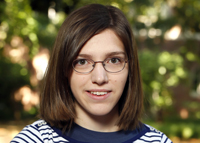 Educational Institution: University of Tennessee, Chattanooga
Educational Institution: University of Tennessee, Chattanooga
List of Mentors: Dr. Rizia Bardhan & Will Erwin
Program: NSF TN-SCORE
Research Project: Large Area Nanoplasmonic Architectures for Solar Applications”
Poster: NSF REU Miranda Trentle Poster .pdf
Research Abstract:
Solar energy represents a transformational energy resource for future sustainability. Everyday ~0.56x1022 J of energy is incident on Earth from sunlight. By efficiently harvesting only 7 % of this incident light in one day, the global energy needs (0.41x1021 J) for one year can be effectively fulfilled. Solar energy driven dye-based and polymer-based organic solar cells offer a promising and inexpensive alternative to crystalline Si solar cells; however, the efficiencies of these organic solar cells remain <10%. Recent advances have demonstrated that plasmon resonances in metal nanostructures can be engineered to enhance carrier collection in adjacent molecules and semiconductors resulting in significant optical enhancements and better performance. However, the integration of plasmonic nanostructures for enhanced photon concentration in organic solar cells remains in its infancy due to the lack of conceptual understanding of plasmonic engineering. Therefore in this project I have designed large area plasmonic architectures with various geometries and dimensions, and unique optical resonances enabling the capture of broadband solar radiation. These wafer scale nanoplasmonic architectures have ideal surface characteristics to directly integrate with organic and inorganic media for solar device fabrication.The plasmonic architectures (nanoholes, Fischer patterns, and nanocups) were designed by nanosphere lithography (NL). In NL a close-pack monolayer of polystyrene or silica nanospheres are formed on a substrate by self-assembly, followed by metal deposition to generate an array of plasmonic architectures. Unlike electron beam lithography which is reproducible but is a slow, expensive process, NL has low precision, but is relatively fast and cost effective. In our approach we casted a closed-packed layer of nanospheres on the surface of water and then transferred the free-floating nanosphere mask on a solid substrate. Long range ordering (~ 1 cm x 1 cm) with very few defects were observed using this method of NL. By using nanospheres of different sizes, and combing Cr/Au deposition by electron beam and reactive ion etching, we generated plasmonic Fischer patterns and nanoholes of variable diameters and pitch length. The plasmon resonances of these large area architectures are highly tunable by simply altering the nanosphere size. Our experimental absorption properties demonstrate a broadband absorption across the visible and near-field overlapping with the solar spectrum. We are currently designing routes to integrate these with standard dye-sensitized solar cells to achieve higher efficiency by plasmonic enhancement.
